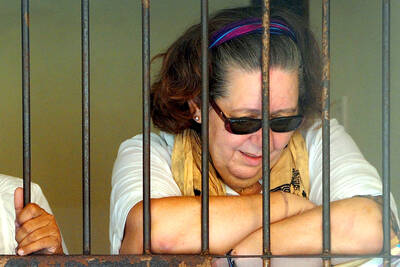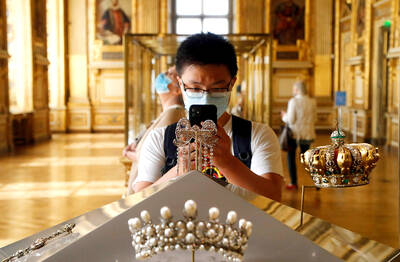Neanderthals and modern humans interbred, probably when early humans first began to migrate out of Africa, according to a genetic study released on Thursday.
People of European, Asian and Australasian origin all have Neanderthal DNA, but not Africans, researchers reported in yesterday’s issue of the journal Science.
The study may help resolve the long-running debate over whether Neanderthals and modern humans did more than simply live side by side in Europe and the Middle East.
“Those of us who live outside Africa carry a little Neanderthal DNA in us,” said Svante Paabo of the Max Planck Institute in Munich, Germany, who led the study.
“The proportion of Neanderthal-inherited genetic material is about 1 to 4 percent. It is a small but very real proportion of ancestry in non-Africans today,” David Reich of Harvard Medical School in Boston, who worked on the study, told reporters in a telephone briefing.
While the findings may lead to jokes about cave-man behavior or looks, Paabo said his team cannot identify any Neanderthal “traits.”
“As far as we can tell these are just random pieces of DNA,” he said.
The researchers used modern methods called whole genome sequencing to examine the DNA from Neanderthal bones found in Croatia, Russia, Germany and Spain, including some crushed leg bones from one Croatian cave that some scientists believe are evidence of cannibalism.
The researchers developed new methods to gather, distinguish and sequence the Neanderthal DNA.
“In those bones that are 30,000, 40,000 years old there is of course very little DNA preserved,” Paabo said.
He said 97 percent or more of the DNA extracted was from bacteria and fungi.
They compared the Neanderthal sequences with DNA sequences from five people from Europe, Asia, Papua New Guinea and Africa.
“Their analysis shows the power of comparative genomics and brings new insights to our understanding of human evolution,” Eric Green, director of the National Human Genome Research Institute at the National Institutes of Health, said in a statement.
The results add to a picture of modern humans living alongside with and interacting on the most intimate levels with similar humans who have now gone extinct.
“It certainly is an indication of what went on socially when Neanderthals and modern humans met,” Paabo said.
“There was interbreeding at some little level. I would prefer to leave it to others who want to quarrel over whether to call us separate species or not,” he said. “They were not genetically very distinct from us.”
The DNA sequences date back to somewhere around 80,000 years ago, when modern humans moving through the Middle East on their way out of Africa would have encountered Neanderthal populations.
The researchers identified five genes unique to Neanderthals, including three skin genes.
“This suggests that something in the physiology or morphology of the skin has changed in humans,” Paabo said.
In March Paabo and colleagues reported they had found a previously unknown human species that lived 30,000 years ago alongside modern humans and Neanderthals in Siberia.
Scientists have speculated that different species of humans lived side by side at various times over the past million years. But many would have lived in tropical zones where bones are not easily preserved.
Paabo said modern-day Africans may carry some of that unknown DNA even if they do not have Neanderthal ancestors.

Indonesia was to sign an agreement to repatriate two British nationals, including a grandmother languishing on death row for drug-related crimes, an Indonesian government source said yesterday. “The practical arrangement will be signed today. The transfer will be done immediately after the technical side of the transfer is agreed,” the source said, identifying Lindsay Sandiford and 35-year-old Shahab Shahabadi as the people being transferred. Sandiford, a grandmother, was sentenced to death on the island of Bali in 2013 after she was convicted of trafficking drugs. Customs officers found cocaine worth an estimated US$2.14 million hidden in a false bottom in Sandiford’s suitcase when

CAUSE UNKNOWN: Weather and runway conditions were suitable for flight operations at the time of the accident, and no distress signal was sent, authorities said A cargo aircraft skidded off the runway into the sea at Hong Kong International Airport early yesterday, killing two ground crew in a patrol car, in one of the worst accidents in the airport’s 27-year history. The incident occurred at about 3:50am, when the plane is suspected to have lost control upon landing, veering off the runway and crashing through a fence, the Airport Authority Hong Kong said. The jet hit a security patrol car on the perimeter road outside the runway zone, which then fell into the water, it said in a statement. The four crew members on the plane, which

Japan’s ruling Liberal Democratic Party (LDP) and its junior partner yesterday signed a coalition deal, paving the way for Sanae Takaichi to become the nation’s first female prime minister. The 11th-hour agreement with the Japan Innovation Party (JIP) came just a day before the lower house was due to vote on Takaichi’s appointment as the fifth prime minister in as many years. If she wins, she will take office the same day. “I’m very much looking forward to working with you on efforts to make Japan’s economy stronger, and to reshape Japan as a country that can be responsible for future generations,”

SEVEN-MINUTE HEIST: The masked thieves stole nine pieces of 19th-century jewelry, including a crown, which they dropped and damaged as they made their escape The hunt was on yesterday for the band of thieves who stole eight priceless royal pieces of jewelry from the Louvre Museum in the heart of Paris in broad daylight. Officials said a team of 60 investigators was working on the theory that the raid was planned and executed by an organized crime group. The heist reignited a row over a lack of security in France’s museums, with French Minister of Justice yesterday admitting to security flaws in protecting the Louvre. “What is certain is that we have failed, since people were able to park a furniture hoist in the middle of